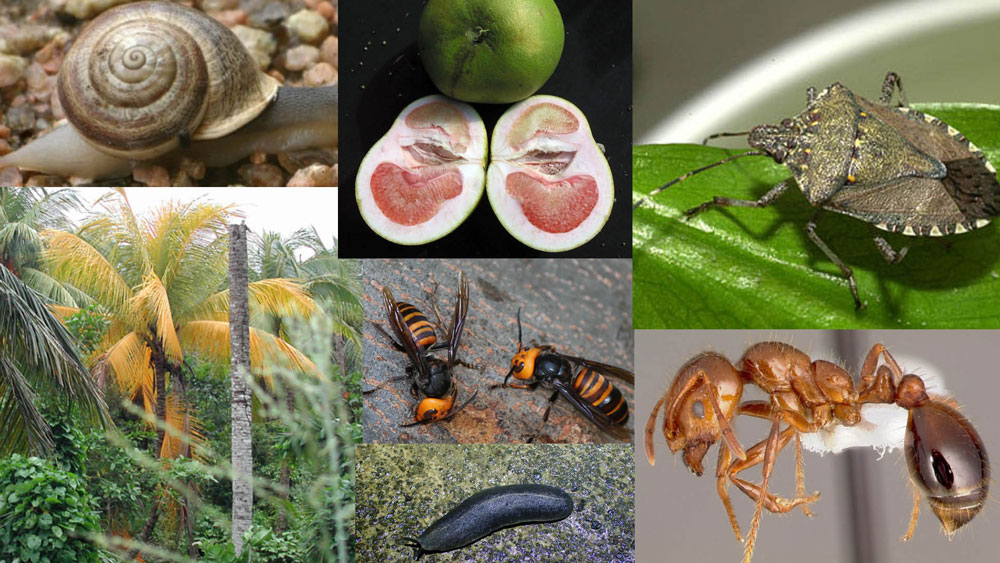Hawaiʻi is home to plant and animal species found nowhere else. For millions of years, new arrivals would establish in our islands an average of once every three thousand years via makani (wind), moana (deep ocean currents), or manu (birds or seeds hitchhiking in their gut). After they arrived to our isolated island chain, they evolved to live in their new environment, becoming new species over hundreds of thousands of years. Today, due to globalization, a new plant, animal, or pathogen that has never been documented in Hawaii arrives every three days. Some of these new arrivals can become invasive, harming not only our environment and Hawaiʻi’s unique biodiversity but also causing adverse effects on our agriculture industry, health, cultural practices, and quality of life.
Multiple agencies across the state work every day to address invasive species issues and local businesses are pitching in. Since many new species arrive hitchhiking on nursery materials, nurseries can be front-line heroes in helping to stop new pests before they spread into the environment.
A new training for nurseries is now available. The Pest Prevention Training Program was created by a grant from the United States Department of Agriculture Animal and Plant Health Inspection Service. The training, offered by the island-based Invasive Species Committees, will feature information about the identification, reporting, and best management practices for some high-risk pests that are either not known to occur in Hawaii, not known to occur in the United States, or pests that are present but are a high priority for containment (like coconut rhinoceros beetle)
Here are some pests not yet found on Maui to be on the lookout for. If you think you’ve seen these pests, report immediately to 643pest.org:

Coconut Rhinoceros Beetle
Currently only found on Oahu, the coconut rhinoceros beetle (CRB). Adults are long (up to two inches), shiny black in color, with a single horn. CRB are nocturnal and can fly. They are primarily found in decomposing green waste or in the crown of palms, where they leave oval-shaped boreholes midrib of fronds or in the crown or trunk of the tree. Fronds cut in a V-shape pattern are another indication of CRB presence. They have also been found in hala trees in Hawaiʻi and can threaten rare native Hawaiian palm species. Extensive damage can kill trees.
Citrus Greening
Citrus greening is bacteria that affect citrus’s vascular system and nutrient uptake. Though not detected in Hawaiʻi, the primary vector, the Asian citrus psyllid, is present in our islands. Throughout the world, the arrival of the Asian citrus psyllid has been followed by the detection of this disease-causing bacteria. This bacterium is responsible for the loss of millions of acres of citrus in the US and beyond. In Florida, citrus greening resulted in 8,000 lost jobs with an economic impact of $4.5 billion. Today, Florida’s citrus industry covers half the acreage it once did. Symptoms include lopsided, bitter, hard fruit with tiny, dark seeds, blotchy mottling on leaves, and fruit that remains green even when ripe.
Red Imported Fire Ant
The Red Imported Fire Ant (RIFA) is an aggressive ground-dwelling ant known for its painful stings. RIFA has resulted in a $1 billion impact in the United States alone. Native to South America, it is a serious pest across the continental U.S. but has not yet been detected in Hawaiʻi. Similar in size and behavior to the well-established tropical fire ant, members of the public are encouraged to submit samples of any stinging ant to their local invasive species committee to prevent an unknown infestation of RIFA from becoming established. Request a free ant collection kit at stoptheant.org.
Lethal Palm Yellowing
Lethal palm yellowing is caused by a bacterial parasite that lives within the plant’s vascular system. This disease affects at least 37 palm species and is responsible for wiping out the majority of the tall-type coconut cultivars in Jamaica and Florida. It can take three to nine months before symptoms are apparent, including yellowing of the leaves and premature dropping of fruit.
Local nurseries can learn more about the Pest Prevention Training as well as the full list of pests to be on the lookout for at plantpono.org/pest-training.
Serena Fukushima is the public relations and education specialist for the Maui Invasive Species Committee. She holds a bachelor’s degree in environmental studies and a graduate degree in education from the University of Hawaii at Manoa. “Kia’i Moku, Guarding the Island” is written by the Maui Invasive Species Committee to provide information on protecting the island from invasive plants and animals that threaten our islands’ environment, economy and quality of life.
This article was originally published in the Maui News on September 10, 2022 as part of the Kia‘i Moku Column from the Maui Invasive Species Committee.
Read more Kiaʻi Moku articles
